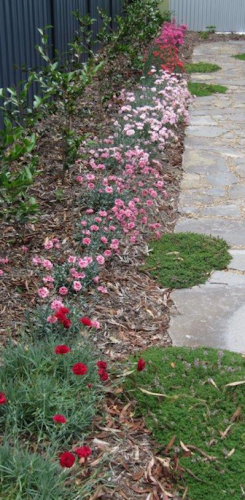
Living mulches can also provide colour all year.
A good example is the ground-hugging carpet thyme, also known as creeping thyme, of which there are many varieties including, Thymus “Annie Doone”, T. “Doon Valley”, T.”Pink Chintz” and T. “Magic Carpet”.
The flower colours range from white to pink or purple. Some have attractive variegated green and gold leaves.

Secondly, pavers absorb a great deal of water, drying the surrounding ground and robbing the soil of moisture.
OTHER ground covers that can add colour include Phlox subulata. Available in a variety of pastel colours, it has a long flowering period from spring to late summer, providing it receives an occasional feed. It blooms equally well in full sun or semi-shade.
The bright-blue flowers of Parahebe “Baby Blue” or P. “Oxford Blue” flower in winter and, at this time, is already in flower.
Convolvulus mauritanicus “Moroccan Beauty” with its summer-long, pale-blue flowers is a toughie. Originating in the desert areas of North Africa, it looks particularly spectacular spilling over rock retaining walls, as illustrated here. It is also available with white flowers.
LET’S not forget great native ground covers.
For a large area to be covered Myoporum parvifolium has a mass of white flowers over a long period. One small plant within a couple of years will easily cover an area 2m x 2m. M.p. “Purpureum” has attractive purple leaves. Brachyscomb “Break O’Day”, commonly called Swan River Daisy due to its WA origins, has masses of tiny blue flowers.
While not technically a ground cover, growing in clumps about 30cm x 30cm, it is most attractive when planted in groups of five or seven.
NOW is the time to core lawns. Coring machines can be hired, although they are not easy to handle (I know horror stories of very heavy coring machines running out of control into garden beds). Alternatively, call an expert. Paul Howard has been coring lawns in Canberra for more than 20 years and has the latest coring/dethatching machinery. Paul’s on 6231 2920.
Jottings…
- Give azaleas, rhododendrons and other acid-loving plants a last feed before full flowering.
- Also, if leaves on the above plants and especially daphne plants are turning yellow with just the dark veins showing, they need a dose of Epsom salts, a heaped tablespoonful to a watering can of water.
- Check the mower blades for the season ahead. Change the oil on four-stroke mowers and touch up rusting paintwork.
Who can be trusted?
In a world of spin and confusion, there’s never been a more important time to support independent journalism in Canberra.
If you trust our work online and want to enforce the power of independent voices, I invite you to make a small contribution.
Every dollar of support is invested back into our journalism to help keep citynews.com.au strong and free.
Thank you,
Ian Meikle, editor




Leave a Reply